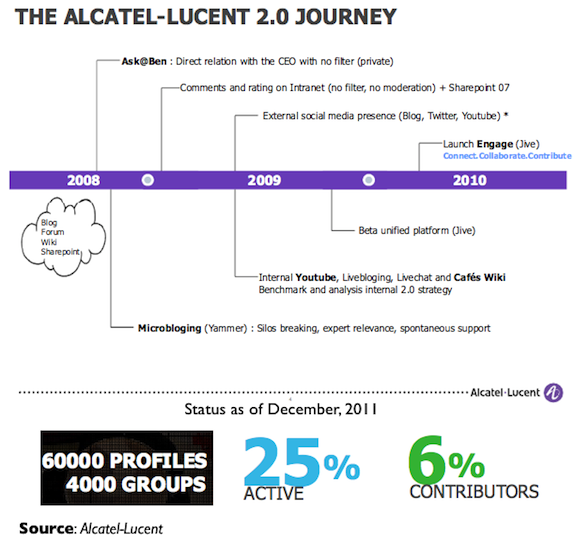Enterprise 2.0 Success: Alcatel-Lucent

This is the first in a ten part series -- you can read the overview here -- that explores the latest examples of enterprise uptake of social media internally. The first company we'll take a look at is telecommunications giant, Alcatel-Lucent, which currently employs nearly 80,000 workers.
Alcatel-Lucent began their adoption of social media inside the organization at least as far back as 2008. Although they already had blogs, forums, wikis, and Sharepoint internally, there really was not an enterprise wide social networking environment or social media strategy at the time. This soon changed with the introduction of Ask@Ben, a system that let workers interact directly with the CEO, and uptake of Yammer, the now well-known enterprise microblogging platform that was becoming common in organizations at the time through viral adoption. These both broke new ground for the company and workers began to become more familiar with social tools to communicate and collaborate with each other and their management.
The next year, 2009, saw more social features emerge in the organization. SharePoint was already widely used in the organization, as it often is in technical environments to manage documents and other important content. As was and still is common for SharePoint environments, social features began to make their way into the platform through additional customization. Soon comments and ratings features, without filtration, were incorporated into SharePoint 2007 early that year. Later in 2009, Alcatel-Lucent pushed outside of the organization and added external social media presence via blogs, Twitter, and YouTube further raising the profile of social media and setting precedent. Other tools began to emerge on the company's intranet towards the end of the year. This included an internal YouTube, live blogging, chat, and other social capabilities. Perhaps more importantly, the organization began to look seriously at developing an internal social media strategy to begin organizing their efforts more formally across the company. This included benchmarking progress and tracking what workers were doing with the new social channels emerging in the company.
Through their experiences in 2009, Alcatel-Lucent decided that it made the most sense to unify much of their enterprise social media to address a myriad of issues that crop up with too many different social tools emerge: Duplicate social identities, a proliferation of content silos, fragmented information discovery, and so on. Towards the end 2009, they launched an internal beta of Jive's social business platform to determine its suitability for a very large enterprise. A profile in ComputerWorld at the time highlighted the amount of preparation and implementation effort it took between considering Jive and actually rolling it out to employees: 13 months, longer than most enterprises I've encountered wish to take before they launched. Spearheaded by Greg Lowe, a collaboration/social media strategist at Alcatel-Lucent at the time, the initial results were quite encouraging, even if they weren't an outright success yet:
The Jive platform was rolled out April 6. Lowe initially sent an e-mail about the service to just 125 people in the company, giving them each a log-in and inviting them to join. Membership spread from there, and Alcatel-Lucent now (July 15th, 2010) has nearly 20,000 registered Jive users. According to Lowe, about 200 to 400 people join every day. On any given day, about 1,000 people use the system in one way or another, he added.
In other words, nearly a quarter of Alcatel's workers created a profile within the first three months, an impressive uptake when as little as 10% can represent critical mass adoption. Today, the companies achievements have continued to grow. A recent presentation on Slideshare explores their current progress: Over 60,000 workers now have a profile and 25% of them are regularly active. 6% of users are contributors, a rate that is considerably higher than it is generally in consumer social media, though lower than some enterprises are experiencing. The staffing picture for the effort is also of note. While I've long emphasized that the technology investment in Enterprise 2.0 is only a small portion of the total spend on social business implementation, community management is one of the most important capabilities to allocate resources for. Though some large companies have not invested in this vital capability, Alcatel current has two full-time community managers on staff, a surprisingly low ratio of CMs to participants, until you consider the additional help they have.
The company also has 20 part-time advocates which help maintain and support some of the over 4,000 collaborative groups that now reside inside in Jive at Alcatel. The use of these collaborative groups varies widely but includes research & development, project-based groups, organic personal groups, and cross-organization special interest groups, to name just a few of the community types.
Alcatel is not stopping at establishing basic social collaboration. They currently have plans to add more transactional social capabilities such as the crowdsourcing of help and support (internal Social CRM), improving corporate communications, and social analytics and metrics to drive improvements to the social business environment and optimize how its employed and supported in the organization.
The lessons here stand out: Two stages, first pilot (Yammer), and then a unified approach across the company (Jive) is a common success pattern and it worked for Alcatel. Unusual however, was the length and deliberate amount of time spent between the two phases to carefully learn what the company really needed in a social business environment. The structure of the support staff (dedicated CMs with volunteer advocates) also brought to bear enough resources to support and guide the participation of workers across the company, without driving up the overhead costs to unsupportable numbers.
Don't miss a single success story. Subscribe to my blog and I'll keep you updated with the latest case studies.
Note: If you'd like to consider adding your organization to this list, represent a Fortune 500 or Global 2000 firm, and have publicly released your data for the first time in approximately the last 24 months, please send me your information via e-mail here.
